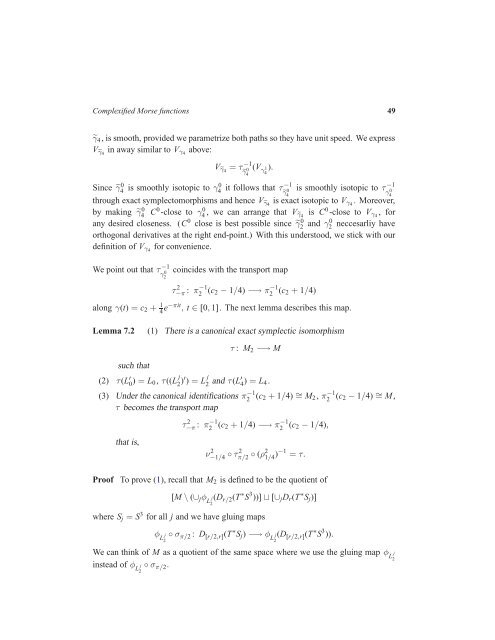The Picard-Lefschetz theory of complexified Morse functions 1 ...
The Picard-Lefschetz theory of complexified Morse functions 1 ...
The Picard-Lefschetz theory of complexified Morse functions 1 ...
Create successful ePaper yourself
Turn your PDF publications into a flip-book with our unique Google optimized e-Paper software.
Complexified <strong>Morse</strong> <strong>functions</strong> 49<br />
γ4, is smooth, provided we parametrize both paths so they have unit speed. We express<br />
Veγ4 in away similar to Vγ4 above:<br />
Since γ 0 4 is smoothly isotopic to γ0 4<br />
Veγ4<br />
−1<br />
= τ<br />
eγ 0 (Vγ1). 4 4<br />
it follows that τ −1<br />
eγ 0 4<br />
is smoothly isotopic to τ −1<br />
γ 0 4<br />
through exact symplectomorphisms and hence Veγ4 is exact isotopic to Vγ4 . Moreover,<br />
by making γ 0 4 C0-close to γ0 4 , we can arrange that Veγ4 is C0-close to Vγ4 , for<br />
any desired closeness. (C0 close is best possible since γ 0 2 and γ0 2 neccesarliy have<br />
orthogonal derivatives at the right end-point.) With this understood, we stick with our<br />
definition <strong>of</strong> Vγ4 for convenience.<br />
We point out that τ −1<br />
γ 0 2<br />
coincides with the transport map<br />
τ 2 −π : π−1<br />
2 (c2 − 1/4) −→ π −1<br />
2 (c2 + 1/4)<br />
along γ(t) = c2 + 1<br />
4 e−πit , t ∈ [0, 1]. <strong>The</strong> next lemma describes this map.<br />
Lemma 7.2 (1) <strong>The</strong>re is a canonical exact symplectic isomorphism<br />
such that<br />
τ : M2 −→ M<br />
(2) τ(L ′ 0 ) = L0, τ((L j<br />
2 )′ ) = L j<br />
2 and τ(L′ 4 ) = L4.<br />
(3) Under the canonical identifications π −1<br />
2 (c2 + 1/4) ∼ = M2, π −1<br />
2 (c2 − 1/4) ∼ = M,<br />
τ becomes the transport map<br />
that is,<br />
τ 2 −π : π−1<br />
2 (c2 + 1/4) −→ π −1<br />
2 (c2 − 1/4),<br />
ν 2 −1/4 ◦ τ 2 π/2 ◦ (ρ2 1/4 )−1 = τ.<br />
Pro<strong>of</strong> To prove (1), recall that M2 is defined to be the quotient <strong>of</strong><br />
[M \ (∪jφ j(D<br />
L r/2(T<br />
2<br />
∗ S 3 ))] ⊔ [∪jDr(T ∗ Sj)]<br />
where Sj = S 3 for all j and we have gluing maps<br />
φ L j<br />
2<br />
◦ σπ/2 : D [r/2,r](T ∗ Sj) −→ φ j(D<br />
L [r/2,r](T<br />
2<br />
∗ S 3 )).<br />
We can think <strong>of</strong> M as a quotient <strong>of</strong> the same space where we use the gluing map φ L j<br />
2<br />
instead <strong>of</strong> φ j<br />
L ◦ σπ/2. 2
















